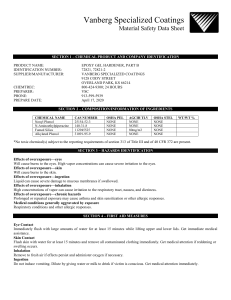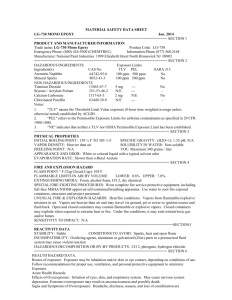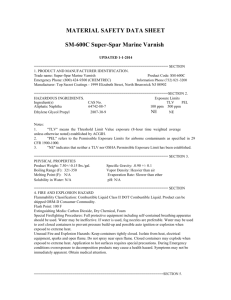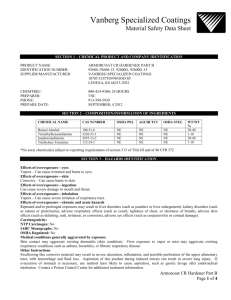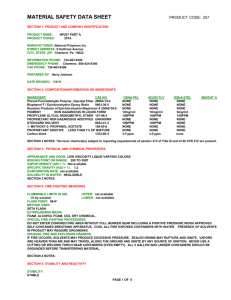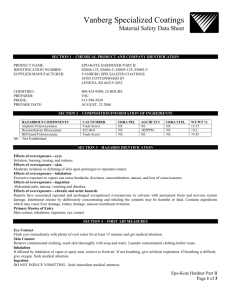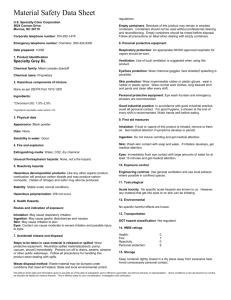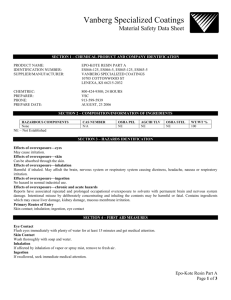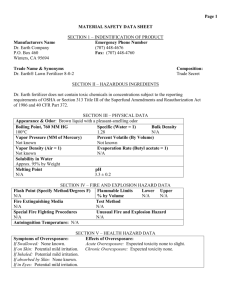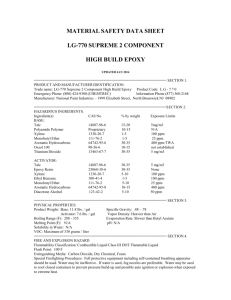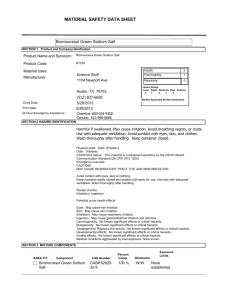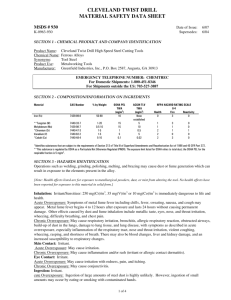section 1 – chemical product and company identification
advertisement
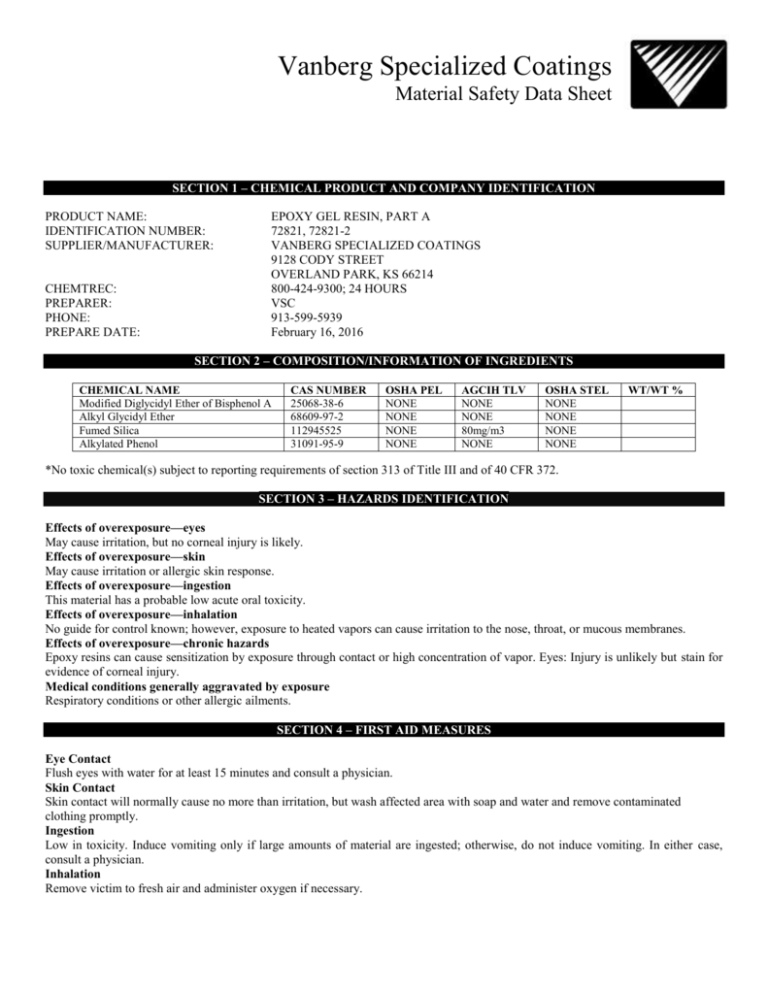
Vanberg Specialized Coatings Material Safety Data Sheet SECTION 1 – CHEMICAL PRODUCT AND COMPANY IDENTIFICATION PRODUCT NAME: IDENTIFICATION NUMBER: SUPPLIER/MANUFACTURER: CHEMTREC: PREPARER: PHONE: PREPARE DATE: EPOXY GEL RESIN, PART A 72821, 72821-2 VANBERG SPECIALIZED COATINGS 9128 CODY STREET OVERLAND PARK, KS 66214 800-424-9300; 24 HOURS VSC 913-599-5939 February 16, 2016 SECTION 2 – COMPOSITION/INFORMATION OF INGREDIENTS CHEMICAL NAME Modified Diglycidyl Ether of Bisphenol A Alkyl Glycidyl Ether Fumed Silica Alkylated Phenol CAS NUMBER 25068-38-6 68609-97-2 112945525 31091-95-9 OSHA PEL NONE NONE NONE NONE AGCIH TLV NONE NONE 80mg/m3 NONE OSHA STEL NONE NONE NONE NONE WT/WT % *No toxic chemical(s) subject to reporting requirements of section 313 of Title III and of 40 CFR 372. SECTION 3 – HAZARDS IDENTIFICATION Effects of overexposure—eyes May cause irritation, but no corneal injury is likely. Effects of overexposure—skin May cause irritation or allergic skin response. Effects of overexposure—ingestion This material has a probable low acute oral toxicity. Effects of overexposure—inhalation No guide for control known; however, exposure to heated vapors can cause irritation to the nose, throat, or mucous membranes. Effects of overexposure—chronic hazards Epoxy resins can cause sensitization by exposure through contact or high concentration of vapor. Eyes: Injury is unlikely but stain for evidence of corneal injury. Medical conditions generally aggravated by exposure Respiratory conditions or other allergic ailments. SECTION 4 – FIRST AID MEASURES Eye Contact Flush eyes with water for at least 15 minutes and consult a physician. Skin Contact Skin contact will normally cause no more than irritation, but wash affected area with soap and water and remove contaminated clothing promptly. Ingestion Low in toxicity. Induce vomiting only if large amounts of material are ingested; otherwise, do not induce vomiting. In either case, consult a physician. Inhalation Remove victim to fresh air and administer oxygen if necessary. SECTION 5 – FIRE FIGHTING MEASURES Flash Point 200+ºF (seta flash) Flammable Limits Not applicable. Extinguishing Media Foam, alcohol foam, CO2, water fog, dry chemicals Special Fire fighting Procedures Do not enter confined area without full bunker gear including a positive pressure NIOSH-approved self-contained breathing apparatus. Cool all fire exposed containers with water. Unusual Fire and Explosion Hazards None known. SECTION 6 – ACCIDENTAL RELEASE MEASURES Spill or Leak Procedures Wear respirator and protective clothing. Shut off the source at the leak. Remove excess with vacuum truck and take up the remainder with an absorbent such as clay and place in disposal containers. Flush area with water to remove residue. SECTION 7 – HANDLING AND STORAGE Precautions Store in a cool dry place. Seal all partially used containers. Wash with soap and water before eating, drinking, smoking, or using toilet facilities. Mixed materials contain the hazards of all the components; therefore, read the MSDS of all the components prior to using material. Properly label all containers. Other Precautions Avoid all skin contact. Avoid breathing vapors generated from the material. Observe conditions of good general hygiene and safe working practices. Contaminated leather articles cannot be cleaned and must be discarded if contaminated with this product. Wash all contaminated clothing prior to the reuse thereof. SECTION 8 – EXPOSURE CONTROLS/PERSONAL PROTECTION Eye Protection Splash-proof goggles or safety glasses with side shields. Protective Gloves Impervious gloves; neoprene or rubber Respiratory Protection Use a NIOSH-approved respirator as required to prevent overexposure to vapor in accordance with 29 CFR 1910.134. General exhaust is usually sufficient in lieu of NIOSH respirator. Ventilation General exhaust is usually sufficient to control vapors and exposure hazards. Other Protective Clothing or Equipment Wear body covering clothing and other coverings as necessary such as apron and appropriate footwear to avoid contact with material. Wash Requirements Observe general good hygienic practices. SECTION 9 – PHYSICAL AND CHEMICAL PROPERTIES Appearance and Odor: Vapor Density: Boiling Range: Evaporation Rate: Specific Gravity: Solubility in Water: Viscous paste, negligible odor Not applicable 200ºF Not applicable 1.2 Negligible SECTION 10 – STABILITY AND REACTIVITY Chemical Stability This product is stable under normal storage conditions. Stability Conditions to Avoid Avoid excessive heat or open flames. Hazardous Decomposition Products CO2, Aldehydes, acids. Reaction with some curing agents can generate large amounts of heat. Hazardous Polymerization Will not occur Incompatibilities (Materials to Avoid) Can react vigorously with strong oxidizing agents and strong Lewis acids or mineral acids. SECTION 11 – HMIS RATINGS Health: Flammability: Reactivity: 1 1 0 SECTION 12 – ECOLOGICAL INFORMATION Environmental Fate No information found. Environmental Toxicity No information found. SECTION 13 – DISPOSAL CONSIDERATIONS Dispose of in accordance with appropriate federal, state, and local regulations. SECTION 14 – TRANPORTATION INFORMATION DOT Shipping Name: DOT Hazard Class: RQ (Reportable Quantity): No information. Not applicable. Not applicable. SECTION 16 – OTHER INFORMATION The information accumulated herein is believed to be accurate but is not warranted to be whether originating with the company or not. Recipients are advised to confirm in advance of need that the information is current, applicable, and suitable to their circumstances.
